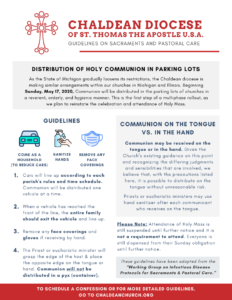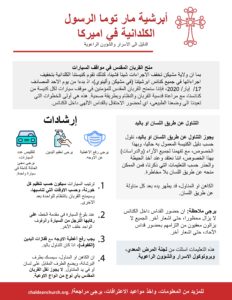Adopted from the “Working Group on Infectious Disease Protocols for Sacraments & Pastoral Care,” distributed on April 28, 2020.
General Principles:
- In cases where the faithful are in their cars (either for a drive-in Mass or drive-up distribution of Holy Communion), the communicants should get out of their cars to receive, one car at a time.
- This is preferable from a public health perspective because it permits the priest, deacon, or the Eucharistic Minister (wearing a mask but not gloves) to stand next to a hand sanitizing station and thus gives them the ability to sanitize his hands after each Holy Communion, if necessary. If the priest walks from car to car or from window to window, this hand hygiene would be difficult.
- It is also preferable from a sacramental perspective because it removes the temptation to pass the Eucharist from person to person in the car, if a passenger is not near an open window, and eliminates the problem of self-communication.
- In addition, distribution of the Eucharist in another vessel or container (a plastic bag, paper cup, or a metal pyx) is not warranted from a public health perspective and may even increase risk: CDC guidance suggests that the virus is not easily transmitted by food, whereas passing other containers from person to person involves more contact with surfaces. From a sacramental perspective, there are additional reasons to discourage this practice, dealing with reverence for the sacrament, the problem of self-communication, the danger of profanation, and the problem of purifying or disposing of containers.
- Communion should be distributed one car at a time (perhaps guided by an usher to direct traffic). This would not constitute a large gathering. In principle, there should be no public health objection to having people exit their cars, one car at a time (perhaps guided by an usher to direct traffic). This would not constitute a large gathering.
- The Precious Blood should not be distributed to the faithful, nor should the faithful receive the Eucharist by intinction (dipping the Body into the Blood). A deacon or a concelebrating priest, if present, may receive by intinction.
- A sufficient quantity of hosts for distribution to the faithful should be consecrated at the Mass.
- A small table should be placed at each communion station, with an unfolded corporal and a bottle of hand sanitizer.
- The priest (and any other ministers distributing Holy Communion) should use hand sanitizer immediately before approaching the tabernacle. He may also don a surgical mask or cloth face-covering in the parking lot.
- The priest should be vested in alb and stole. The deacons also in an alb and stole. The Eucharistic Ministers in at least an alb.
- The faithful should remove any face coverings before coming forward for Holy Communion. Holy Communion may not be distributed with gloves, nor may it be received in the hand if a member of the faithful is wearing gloves.
- Hand hygiene is effective against the virus. In these circumstances, gloves are not needed if the priest performs hand hygiene.
- Hand hygiene is effective against the virus. In these circumstances, gloves are not needed if the priest performs hand hygiene.
- The faithful receive Holy Communion in the normal way.
- If the priest senses that his fingers have made contact with a person’s hands or mouth, he should pause, place the ciborium on the corporal, and use hand sanitizer.
- He may also arrange for an ablution cup to be on the table and may purify his fingers in the ablution cup before using hand sanitizer.
- He may repeat this process as often as he deems necessary during the distribution of Holy Communion.
- It is not necessary, however, for him to use hand sanitizer between each communicant unless he makes actual contact.
- Communion on the tongue vs. in the hand: We have carefully considered the question of Communion on the tongue vs. Communion in the hand. Given the Church’s existing guidance on this point (see Redemptionis Sacramentum, no. 92), and recognizing the differing judgments and sensibilities that are involved, we believe that, with the precautions listed here, it is possible to distribute on the tongue without unreasonable risk.
- Opinions on this point are varied within the medical and scientific community: some believe Communion on the tongue involves an elevated and, in the light of all the circumstances, an unreasonable risk; others disagree.
- If Communion on the tongue is provided, one could consider using hand sanitizer after each communicant who receives on the tongue.
- After the distribution of Holy Communion, the priest (and any other ministers) return the remaining hosts to the tabernacle.
For the full detailed guidance on how Catholic sacraments could be provided in the midst of the current pandemic, visit thomisticinstitute.org/covid-sacraments.


